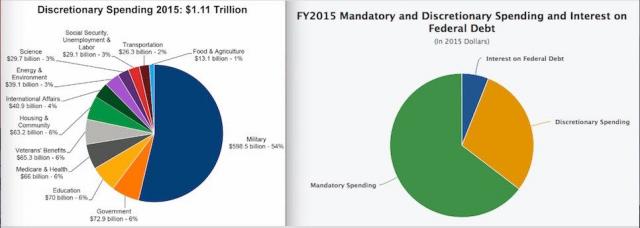Economist Dean Baker, in an article published at NationofChange, complains that the New York Times never explains the federal budget in a way that Americans can comprehend, because it publishes big numbers, like the $17.3 billion budgeted to be spent on Temporary Assistance for Needy Families or the $40 billion budgeted to be spent on foreign aid this year, but never notes that neither of those “big” numbers amounts to even 1% of the 2017 federal budget. His critique is correct as far as it goes, but like all too many liberal analysts, Baker studiously fails to note a few really BIG numbers in the budget that also don’t get mentioned by the Times and the rest of the corporate media, either as a number or as a percentage.
This is a big failing of the liberal left: not calling out the Hannibal’s war elephant in the room.
Military spending, even when it does get reported, is often only referred to in terms of the increase being proposed, without the total budget outlay ever being provided. It is reported (including in the Times!) wrong in so many ways. For example, while the actual Pentagon budget outlay is sometimes mentioned, the amount of the interest on the debt that is for prior military spending that was financed through borrowing is not included. Nor is the spending on veterans’ health care, which is surely part of military spending. Nor is the share of the Energy Department budget that is for nuclear weapons included. According to the National Priorities Project, the 2015 budget for the military was $598 billion, which represented 54% of all federal discretionary spending. That number didn’t include over $100 billion in veterans spending and $26 billion for nuclear weapons, bringing the total to about $730 billion. 2015 total discretionary spending was $1.1 trillion,so including nuke spending and veterans spending, spending on the military represented 63% of the total. In other words two-thirds of your tax bill!
 (National Priorities Project chart)
(National Priorities Project chart)
Discretionary spending is spending that Congress can cut, and that is funded through borrowing or through income tax and other federal tax collections. Other spending, called mandatory or non-discretionary, is primarily for Medicare and Social Security, iand s non-discretionary, as it is mandated and has been funded through separate tax collections — the FICA tax and the Medicare tax, or committed by law as a first priority, like debt repayment. Interest payments on US debt in 2015 was about $440 billion, about a quarter of that, ,or $110 billion, according to the Straus Military Reform Project, being for interest on borrowing to fund wars and the military (this group’s site also has figures for US military spending in the current year FY2016 and the proposed budget for FY2017).
One of the tricks of the trade, often used by the Times, is to lump non-discretionary spending together with discretionary spending and then to describe military spending as a percentage of the whole, which is grossly misleading. That equation: $3.36 trillion was the figure for total federal outlays in 2015. So by that reckoning, the military spending looks like a more reasonable 21.7% of the total. That could be made a bit more honest by adding the $110 billion in war-related interest payments to the military outlays, which would make it 25% spent on the military, but the Times does none of that, and doesn’t include Veterans or Energy Department outlays. The paper typically counts just current Pentagon budgeting which is that $598 billion figure for 2015, and then gives that as a percentage of the total discretionary and mandatory budget of $3.8 trillion, making it look like the military share of that budget was just 16%.
No wonder Americans aren’t freaking out about how much of their tax dollar goes to the military. They think it’s 16 cents of each dollar, when it’s really the percentage of the discretionary budget, which is that 66 cents on the dollar.
Want to know why Americans pay more in taxes than people in the Nordic countries or Europe, with all their fine infrastructure, good schools, national health care systems and one month or even 6-8 weeks of paid vacations? It’s because European countries pay at most maybe 5-6% of their taxes for their military forces, and we suckers in the US pay 66.3% for ours.
As tax day rapidly approaches, remember this figure and tell your friends and neighbors about it, and remind them that President Trump is calling for giving the Pentagon another $54 billion in this year’s budget (and by the way, President Obama and Congress raised the military budget by 6% in 2016, and Obama proposed giving the Pentagon another $29 billion for FY2017, so it’s not just a Republican or a Trump thing).
Note: One could argue that the US spends even more on war and things military by looking at the whole National Security budget, since virtually all of that is about the so-called “war” on terror, under which the US is defined as part of a global “battle ground.” That would mean adding over $40+ billion — probably closer to $50 billion now — for the intelligence agencies like the CIA and NSA whose budgets are kept secret, but a few years ago managed to leak out in a Congressional hearing, the budget for the FBI of $9 billion, and the budget for the DEA of $28 billion. That’s another $80 billion to add to the total military budget, bringing it to over 67% of total discretionary spending.
